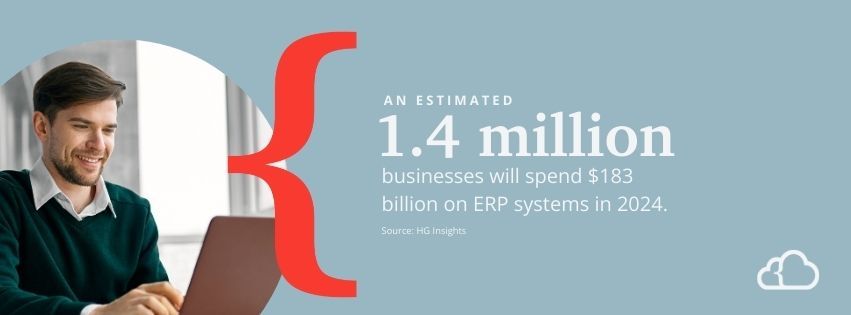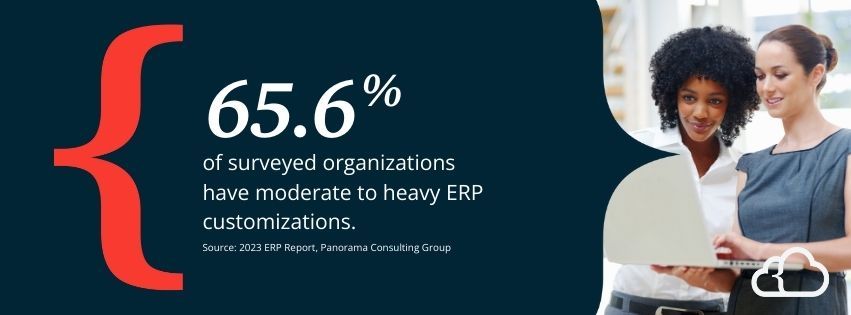NetSuite ERP: How to Unify Your Systems on One, Easy Platform
Your business can't get far with a tangled web of disparate systems. ERP software straightens out your data flows and streamlines your processes.
Growing a company takes more than hard work and perseverance—it takes efficiency. A business’s operations must work seamlessly together to create the highest production rate possible with the fewest resources. It must also eliminate data siloes, allowing information to flow freely between departments and empower leadership to make sound decisions.
Enterprise Resource Planning (ERP) platforms consolidate all of a company’s systems—including financial, warehouse, and inventory management—onto one database. This unification establishes a single data source, streamlining the information flow so operations work more efficiently.
SuiteDynamics partners with NetSuite to customize and implement NetSuite ERP systems. This platform is the #1 Cloud ERP system, serving over 38,000 customers worldwide. Our experts can help examine your company’s software needs and devise NetSuite solutions that equip it to exceed its loftiest goals.
Schedule a consultation with our team today to discuss your dream operation. We’ll ensure you have the system you need to make it a reality.
Key Takeaways
- Unified Business Operations - An ERP (Enterprise Resource Planning) system is a digital engine that runs a company by managing all business operations on a single platform, allowing organizations to track everything from raw materials to finished products to finances within one program.
- Modular Functionality - Most ERPs operate through interconnected modules like Financial Management, Warehouse Management, Inventory Management, Customer Relationship Management, and Supply Chain Management, all sharing data through a central database for real-time access across departments.
- Broad Business Applications - ERP solutions benefit companies of all sizes across diverse industries by eliminating inefficiencies, facilitating accurate reporting, providing real-time project updates, strengthening financial controls, and increasing customer satisfaction.
- Deployment Flexibility - Organizations can choose from several deployment models: cloud-based (98% of professionals see this as the future), on-premises (housed on company servers), hybrid (combining both approaches), or open-source (typically requiring self-configuration).
- Implementation Considerations - While ERPs offer substantial benefits when properly implemented (as seen in All-Safe's case with doubled productivity and 25% sales increase), nearly 50% of implementations fail without proper planning or partnership with experienced consultants who can customize the system to specific business needs.

What is an ERP?
Think of an ERP as the digital engine that runs a company. In its simplest definition, an ERP is software that manages all business operations on a single platform.
For example, a shoe manufacturer might use a NetSuite ERP to run its accounting, inventory management, and supply chain management systems. Consequently, it would only need one program to track the flow of raw goods to its factory, the items in its warehouse, the packaging and shipping of those items to customers, and the finances associated with the business.
More and more companies are seeing the value in program unification. In fact, HG Insights estimates that 1.4 million businesses will spend $183 billion on ERP systems in 2024.
“ERP systems have become table stakes for businesses looking to use resources wisely,” NetSuite Senior Associate Content Manager Ian McCue writes. “They can help leaders reallocate human and financial capital or build more efficient core business processes that save money without sacrificing quality or performance.”
Many ERP platforms use a system of modules to handle various operations, connecting them through a central database. Some of the most common modules are:
- Financial Management – Found in almost all ERPs. It tracks all transactions, decreases budgeting and forecasting cycle times, accelerates financial close, and ensures compliance.
- Warehouse Management – Manages warehouse activities, like packing and shipping. It also increases their efficiency.
- E-commerce – This module allows users to manage an online store’s front- and back-end operations.
- Inventory Management – Shows inventory numbers (updated in real-time) and tracks related metrics.
- Human Resource Management – Manages employee records and tracks workforce trends.
- Customer Relationship Management – Improves customer service by managing client communications and facilitating leads.
- Order Management – Organizes customer orders and then tracks them to delivery.
- Marketing Automation – Helps create a system for building and executing marketing campaigns and measuring their success.
- Supply Chain Management – Tracks and manages goods as they journey from supplier to manufacturing to customers.
A company can have these modules customized to suit its needs. If an ERP is implemented correctly, various departments can access each system and pull updated data in real-time.
Ultimately, an ERP equips each company division with a wealth of accurate data and analytics, eliminating inefficiencies and data duplications and helping leaders make better decisions.
Schedule a consultation with the SuiteDynamics team to learn more about the NetSuite system and how it can smooth company operations. We’ll ensure the software fits your unique processes, equipping your company to rise in the marketplace.

Who Uses an ERP?
Various companies—from billion-dollar corporations to mid-size and small businesses—have benefited from ERP investments. The software’s modules give it flexibility and help it scale with the business as it grows. They also allow ERPs to suit nearly any industry, from consulting to hospitality to wholesale distribution.
Many businesses deploy ERPs after growing frustrated with single-point solutions, which only address one issue within a company. They don’t coordinate information between departments and are prone to duplications, errors, confusion, and delays.
Instead, companies opt for an ERP that:
- Cuts costs by eliminating inefficiencies, automating simple tasks, and minimizing errors.
- Facilitates thorough and accurate key performance indicator reporting and tracks meaningful trends. Consequently, users get overall views of company health as well as detailed business insights.
- Provides authorized employees fast access to real-time project updates from any area of the company.
- Tracks each transaction and automates simple financial tasks to produce accurate financial reports that comply with reporting standards and governmental data security regulations.
- Strengthens financial controls.
- Allows employees to access information from any device—anywhere in the world.
- Guards data with the best possible security technology.
- Allows for minor to significant operational changes as the company grows.
- Increases customer satisfaction by tracking support tickets, survey responses, etc.
Of course, companies can always adjust the software, adding new capabilities that fit unique needs. Panorama Consulting Group’s 2023 ERP Report says 65.6% of surveyed organizations have moderate to heavy ERP customizations.
“While most companies find that modern ERPs support their businesses ‘out of the box,’ some firms need to add to the extensive built-in functionality,” McCue writes. “If you have a lot of specialized processes, look for an extensible system that allows your integrator or IT staff to write code that adds needed features or that can integrate with homegrown or legacy solutions.”
SuiteDynamics experts specialize in NetSuite customization and can equip your company with bespoke software solutions that enhance your ERP and mold it to your operations. Schedule a consultation to learn more about the system that can streamline your unique processes and boost productivity.

Types of ERP Deployment Models
Most ERP systems have three deployment models, which give your company options for housing and interacting with the platform.
Cloud-Based—This deployment model houses software on third-party servers located off-site. Company employees can then access the platform through a web browser from anywhere in the world.
Providers often offer cloud-based ERPs through a software-as-a-service (SaaS) delivery model. So, they are responsible for managing, upgrading, and patching the system.
Many businesses now opt for this type of ERP because it offers greater flexibility than on-premises models and doesn’t require expensive servers and additional IT staff.
In fact, 98% of surveyed ERP data professionals believe the platform’s future lies with the cloud, according to a study from Frivetran and Dimensional Research.
On-Premises —When they first appeared in the early 1990s, all ERPs were on-premises systems. This means they were housed in servers owned by the businesses that used them and located on company property.
Although current technology has dented their popularity, on-premises ERP systems still exist. Businesses that use this deployment model are responsible for their ERP’s maintenance, security, upgrades, and patches. The upkeep often requires an entire IT staff.
Hybrid – Some companies, especially those who have used on-premises ERPs for years, opt for a hybrid approach, combining elements of on-premises and cloud-based deployment models. They may use the on-premises platform for their headquarters and switch to a cloud-based ERP for regional offices or use the two systems for different functions.
Open-Source – Some providers offer inexpensive—or even free—ERP software. Of course, there’s a catch. Users receive little support and typically must configure the platform themselves.
ERP in Action: The All-Safe Story
More than a decade ago, All-Safe Pool Safety Products was experiencing problems.
The business couldn’t manage ballooning data volumes on its QuickBooks software. That accounting system also didn’t integrate with All-Safe’s CRM and inventory systems, so the company couldn’t easily access critical business information. Ultimately, software issues caused delays and hampered growth.
All-Safe decided to implement a NetSuite ERP system in 2007. This platform tied all the individual systems together, allowing operations to run more efficiently.
Then, business changed for All-Safe. The company saw steady growth post-ERP implementation. Productivity doubled through on-demand access to financial, inventory and customer information. All-Safe experienced a 25% increase in B2C sales because sales reps and managers gained complete sales force automation and lead-to-order-to-cash management.
Why did a single system make such a difference for this company? The secret lies in the free flow of information between departments and employees.
NetSuite ERP Implementation Made Easy
An Oracle NetSuite ERP may smooth a company’s operations and eliminate inefficiencies, but the platform can get complicated. Many companies that try to implement it themselves often fail, which creates more work and headaches for their staff. Technology Evaluation Centers reports that nearly 50% of implementations fail the first time without third-party oversight or planning with an ERP partner.
We don’t want your hard work and financial resources to go to waste. SuiteDynamics is a NetSuite Alliance Partner and can help your company implement and customize an Oracle NetSuite ERP to fit your specific needs. Our expertise and ongoing support will protect you from the system’s pitfalls so you only experience its benefits.
Shasta Hague is a SuiteDynamics Delivery Manager with over a decade of NetSuite expertise and more than five years in consulting. Her career began in accounting, where she rose from accounting clerk to CFO before transitioning to a Lead Financial Consultant and, ultimately, advancing to her current leadership role. She holds numerous NetSuite certifications—including Suite Foundations, NetSuite Administrator, Financial User, Advanced Revenue Management, and Multi-Book—and an MBA with an emphasis in accounting from Grand Canyon University. Currently, Shasta resides in Tennessee with her husband and two of her four children.
We pull information from NetSuite material, SuiteDynamics experts, and other reliable sources to compose our blog posts and educational pieces. We ensure they are as accurate as possible at the time of writing. However, software evolves quickly, and although we work to maintain these posts, some details may fall out of date. Contact SuiteDynamics experts for the latest information on NetSuite ERP systems.











